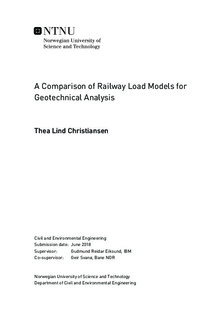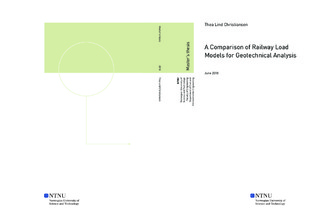| dc.description.abstract | Bane NOR is responsible for developing the railway network in Norway. In Norway, the Eurocodes are specifying how structural design in general should be conducted. This also applies to the railways. To guide those responsible for developing the railway network in Norway, Bane NOR has developed a set of design rules called technical regulations. These regulations aim to meet the requirements from the European standards.
The load model in the Eurocode representing vertical loading due to normal rail traffic actions on earthworks is called Load Model 71. It is described by four axle loads Qvk = 250 kN over the length 6.4 m, and a line load qvk = 80 kN/m outside this length. The technical regulations developed by Bane NOR describes the loads from railways as a line load q = 110 kN/m for most cases. In February, a rule to check for Load Model 71when doing calculations considering sheet pile walls was included. Bane NOR is currently investigating whether their load model considering geotechnics meets the requirements specified in the standard.
Throughout this master s thesis, the results from simulations done in PLAXIS 3D will be presented. Focus will be to find the differences between these two load models. For the assessment of the problem, two different case studies will be conducted. One of them will look into slope stability and the other one investigates how the load models affects a sheet pile wall adjacent to the track.
In advance of the simulations, calculations has been done to illustrate the difference between 2D- and 3D-modelling in PLAXIS, and to figure out the best design of the models in PLAXIS 3D. Results from these calculations shows that PLAXIS 2D is a more accurate modelling program than PLAXIS 3D. Other calculations illustrates that the lower the height of the slope, the greater the differences between the load models, and that the differences will increase with the absence of a frost protection layer.
From the slope stability analyses it is found that the applied line load q = 87 kN/m gives the same safety level in the model as when applying Load Model 71. The simulations of the sheet pile wall adjacent to the track gives results showing that the response in the wall when Load Model 71 is applied is close to the one that occurs when applying the line load q = 125 kN/m.
Even though more research should be done prior to any revisions of the regulations, the results in this thesis can be used as basis. The obtained final results provides background to suggest that the line load can be reduced for slope stability analyses. For calculations considering sheet pile walls adjacent to the track, it seems that Bane NOR did right when they included the requirement to check for Load Model 71. If a line load is to be included in the regulations for this case, it seems that the value has to be higher than 110 kN/m. | |

